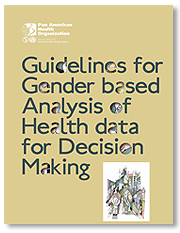|
Working in partnership with the Gender, Health and Ethnicity Unit of the Pan-American Health Organization (PAHO), PWHCE developed two guides to aid health planners, policy makers and researchers in conducting gender-based analyses (GBA) of health surveillance data.  The guides were intended to support the efforts of Central American planners and stimulate greater attention to gender differences in health in that region. However, they also provide a useful model for anyone who seeks to build understanding of GBA's concepts, analytical approach, key resources, and processes, as well as useful elements for the presentation of results and implications of a GBA. The guides were launched at a workshop for health planners held in June 2008 in Belize City, and continue to form the basis of further cooperation with PAHO and Central American planners. The guides were intended to support the efforts of Central American planners and stimulate greater attention to gender differences in health in that region. However, they also provide a useful model for anyone who seeks to build understanding of GBA's concepts, analytical approach, key resources, and processes, as well as useful elements for the presentation of results and implications of a GBA. The guides were launched at a workshop for health planners held in June 2008 in Belize City, and continue to form the basis of further cooperation with PAHO and Central American planners.
Guidelines
for Gender Based Analysis of Health Data for Decision Making
More information on these reports is available on the PAHO website:
English,
Spanish.
This guide presents the basic elements for developing a gender-based
analysis using health statistics, and includes some case studies
based on data derived from Belize. This tool highlights the importance
of using data disaggregated by sex, age, socioeconomic level,
ethnic group, sexual orientation, geographic area, and other factors,
in specific contexts, and whenever possible.
A gender-based analysis considers how gender roles and norms interact
with biological sex differences to influence women's, men's, boys'
and girls' health. This analysis is crucial for effective and
targeted decision making.
Guidelines for Developing a Population
Based Gender and Health Profile
More information on these reports is available on the PAHO website:
English,
Spanish.
This guide describes the information needed and the steps to take
to present a profile of specific-or several-health -related issues,
using a gender-based analysis. It follows the methods described
in the 'Guidelines for Gender based Analysis of Health data for
Decision Making'. Statistical information forms the basis for
a gender analysis, which sensitizes planners and policy makers
to health inequalities that are avoidable and unfair, and contributes
to developing better programs and policies. |
Back to top of page
|




 The guides were intended to support the efforts of Central American planners and stimulate greater attention to gender differences in health in that region. However, they also provide a useful model for anyone who seeks to build understanding of GBA's concepts, analytical approach, key resources, and processes, as well as useful elements for the presentation of results and implications of a GBA. The guides were launched at a workshop for health planners held in June 2008 in Belize City, and continue to form the basis of further cooperation with PAHO and Central American planners.
The guides were intended to support the efforts of Central American planners and stimulate greater attention to gender differences in health in that region. However, they also provide a useful model for anyone who seeks to build understanding of GBA's concepts, analytical approach, key resources, and processes, as well as useful elements for the presentation of results and implications of a GBA. The guides were launched at a workshop for health planners held in June 2008 in Belize City, and continue to form the basis of further cooperation with PAHO and Central American planners.